Menus
- One or two cylinder?
- Minimalism of the Ducati Hypermotard 939
- Lean angle is generously measured
- KTM 690 SMC R does not require counter-steering
- Motor superiority of the Ducati Hypermotard 939
- Technical specifications
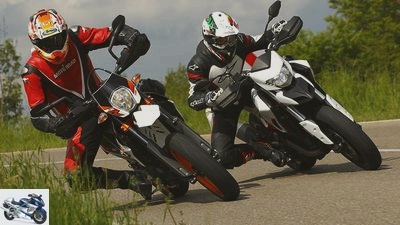
www.bilski-fotografie.de

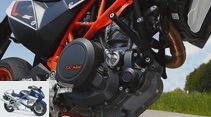
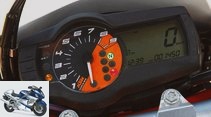
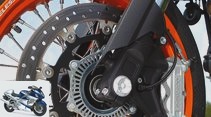
24 photos
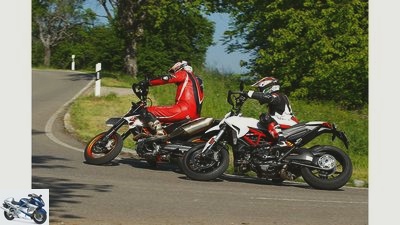
bilski-fotografie.de
1/24
Ducati Hypermotard 939 and KTM 690 SMC R in the test.
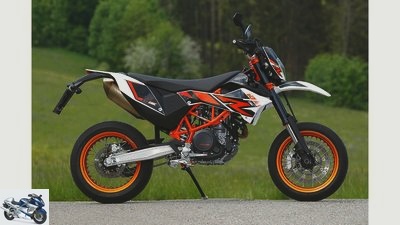
bilski-fotografie.de
2/24
It develops 67 hp and provides a maximum torque of 64 Nm at 6000 rpm.
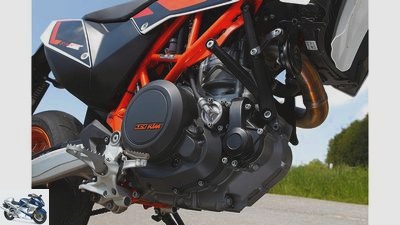
bilski-fotografie.de
3/24
According to the test bench, it is 71 hp; the latest LC4 even has 78 hp.
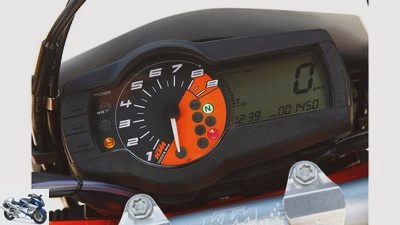
bilski-fotografie.de
4/24
Old style, but functional: the rough charm of the instruments suits the bike.
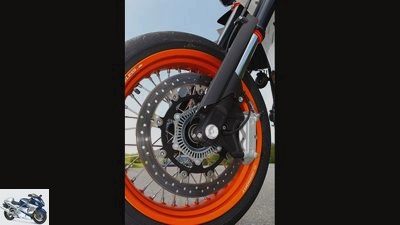
bilski-fotografie.de
5/24
A single 320 mm disc is sufficient for the KTM 690 SMC R for powerful deceleration.
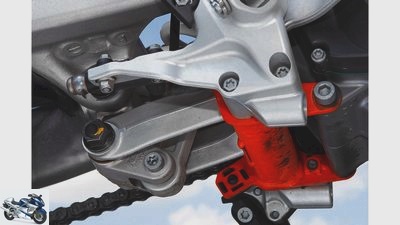
bilski-fotografie.de
6/24
Redirection is nice: thanks to the lever at the rear, the 690 springs harmoniously at the rear.
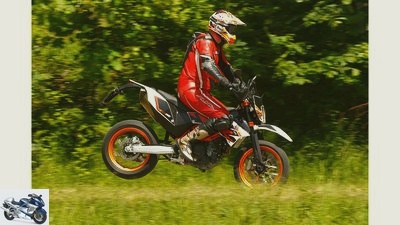
bilski-fotografie.de
7/24
The KTM 690 SMC R reaches a top speed of 180 km / h.
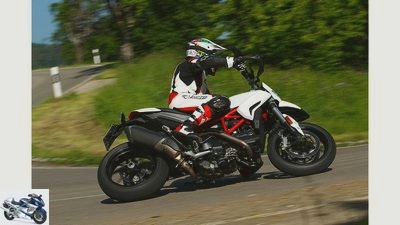
bilski-fotografie.de
8/24
With the Ducati Hypermotard 939 it is max. 220 km / h.
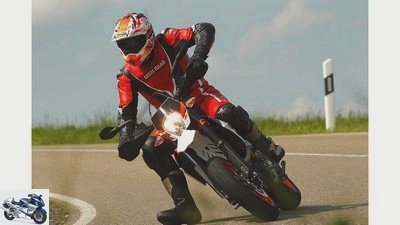
bilski-fotografie.de
9/24
The price for the KTM 690 SMC R is: 8,995 euros.
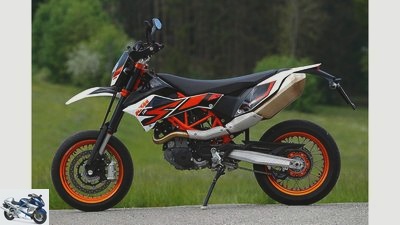
bilski-fotografie.de
10/24
The KTM 690 SMC R only weighs 156 kilograms with a full tank.

bilski-fotografie.de
11/24
The Ducati Hypermotard 939 weighs 207 kilograms with a full tank.
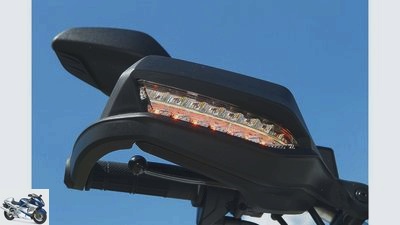
bilski-fotografie.de
12/24
The indicators of the Ducati Hypermotard 939 are integrated in the hand protectors.

bilski-fotografie.de
13/24
Ducati Hypermotard 939 and KTM 690 SMC R in the test.

bilski-fotografie.de
14/24
Single-cylinder or two-cylinder – this is the question the i.a. Rotate test.
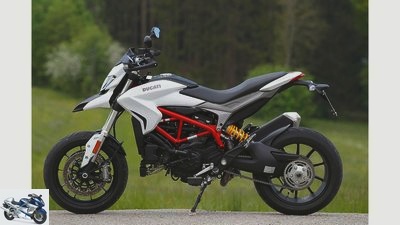
bilski-fotografie.de
15/24
The newly renovated Ducati Hypermotard 939 has been homologated according to Euro 4.
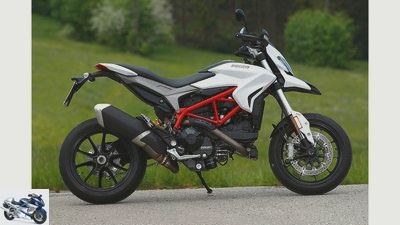
bilski-fotografie.de
16/24
Not just one more cylinder: the Hypermotard also has more displacement – 937 cm³.
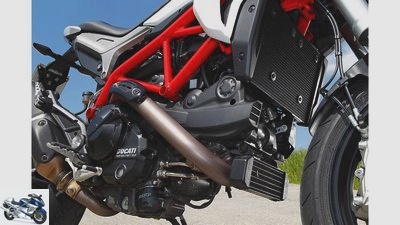
bilski-fotografie.de
17/24
The Desmo of the Ducati Hypermotard 939 develops 110 hp and provides a maximum of 98 Nm at 7500 rpm.
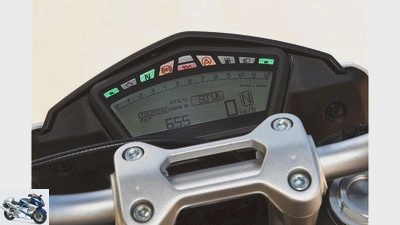
bilski-fotografie.de
18/24
Less would be nothing: The instruments of the Ducati Hypermotard 939 are very compact, but provide comprehensive information.
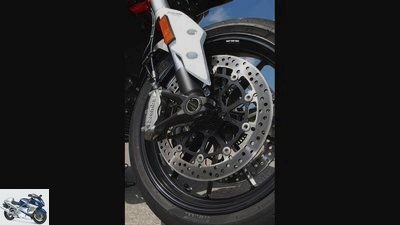
bilski-fotografie.de
19/24
It doesn’t take more than that: Brembo calipers on two 320 mm discs provide excellent deceleration.
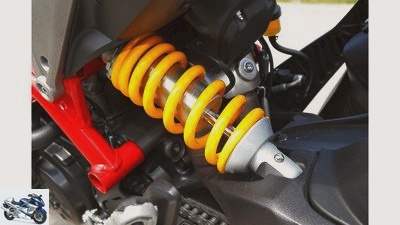
bilski-fotografie.de
20/24
Redirection would be nice: The directly hinged strut is quite tight.
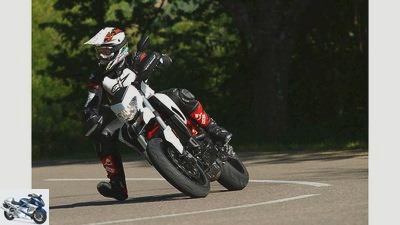
bilski-fotografie.de
21/24
The Ducati Hypermotard 939 costs 11,890 euros.
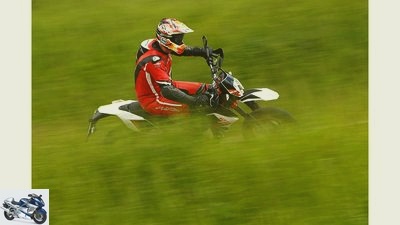
bilski-fotografie.de
22/24
Ducati Hypermotard 939 and KTM 690 SMC R in the test.
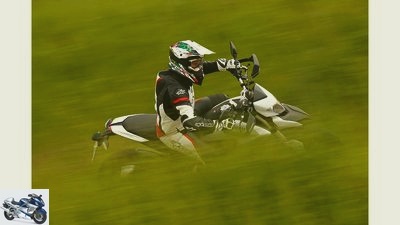
bilski-fotografie.de
23/24
Ducati Hypermotard 939 and KTM 690 SMC R in the test.
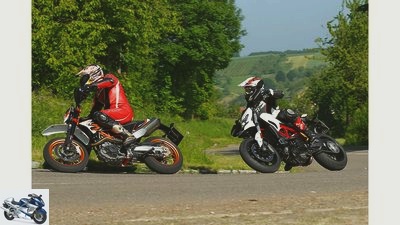
bilski-fotografie.de
24/24
Ducati Hypermotard 939 and KTM 690 SMC R in the test.
Ducati Hypermotard 939 and KTM 690 SMC R in the test
One or two cylinder?
Supermotos are pure, wonderful irrationality. The simple idea is: a minimum of motorcycle for a maximum of driving pleasure. Ducati’s newly redesigned Hypermotard 939 raises a simple question: does a supermoto have to be a single cylinder??
Are supermotos dead? If you define the concept narrowly, as a single cylinder, you should actually say yes. The great hype about the wiry Winkelwerk drifters, sometime around the turn of the millennium, has long been forgotten. Why? The concept seemed too pointed, too special, and the bottom line was simply too unreasonable for the majority of motorcyclists. Today there is actually only one real sports supermoto left, the KTM 690 SMC R, along with the almost identical sister company Husqvarna 701. Who else, apart from KTM, should keep the SuMo fire? The 690 stands alone in terms of performance, and over time it has gained a not-so-small fan base. She is the long-running favorite in the Austrians’ program, and as a surprise guest she is always in the top ten for admissions.
Buy complete article

Ducati Hypermotard 939 and KTM 690 SMC R in the test
One or two cylinder?
Ducati Hypermotard, most recently as a water-cooled 821.
Minimalism of the Ducati Hypermotard 939
The new Euro 4 edition in the form of the Ducati Hypermotard 939 is an occasion for us to compare the concepts. Which supermoto does it, single or twin? This is all about the tightened curve swing that sporty pilots know and love. No go-kart track, no suitcases, no scoring. Milling only. Are the 40 hp more power of the Ducati Hypermotard 939 or the 50 kilo weight advantage of the KTM 690 SMC R stinging? Can a two-cylinder even exude real Supermoto flair, or does the Duc just go out on its feet?
First contact with the Ducati Hypermotard 939 in innocent white. In fact, there is practically no part on this motorcycle that you don’t need to drive. Frame, motor, wheels, some elegant plastic, done. Minimalism, that’s how Supermoto works. The ergonomics also suggests good things. The Ducati looks outrageously compact and narrow, the seat bench is typically high and the handlebars wide and low. In front of the pilot, apart from the small instrument cluster, there is only a winding strip of asphalt. The Hypermotard devours the same with undisguised, almost exaggerated pleasure, so it requires a little getting used to. Steep steering head, little caster – the geometry of the Ducati Hypermotard 939 is pretty crisp. In the first bends, especially on a cold Pirelli Diablo II, it seems a bit inharmonious, almost wobbly. But if the tire is kneaded warm and the driver’s motor skills are calibrated to the vehicle, things can really go smoothly.
Lean angle is generously measured
Yes, the Ducati Hypermotard 939 looks for the tight radius on its own, wants, not completely neutral, in long arcs down further and further. But you can let her get away with that as a child’s greed for curves, after all, in return, she inspires in tight alternating curves with a striking instinct to play. It can be thrown from curve to curve with very little effort over the wide handlebars. The radius closes unexpectedly, shock moment? The Hypermotard has just been waiting for that, it just kicks a little further and good. In addition, the lean angle is lavishly measured on the country road. And the chassis also plays its part. The front fork does not allow any adjustment of the damping settings (if you want this, you have to go for the expensive SP variant with Ohlins), but it responds cleanly and dampens smoothly. Only the directly hinged rear shock absorber (adjustable preload and rebound damping) should work a bit more sensitively, and there is a noticeable righting moment when braking. The bottom line, however, is that the driving behavior of the Ducati Hypermotard 939 in itself offers highly authentic Supermoto pleasure.
For a two-cylinder, you have to add it to the KTM 690 SMC R after switching. Because the description of Hypermotard handling made here as being extremely playful, KTM quickly makes this clear, with the usual perspective of the naked bike rider on country roads. In other words: the 690 single-cylinder supermoto simply shifts the view of what is possible with a motorcycle that can be registered. Primarily responsible for this is the extremely low weight of 156 kilograms. Full tank, of course. That is almost ten kilograms less than the already quite consumptive 690er Duke and, as already noted, a hundredweight or more clearly a more consumptive pillion less than the Ducati Hypermotard 939. What that means on the road, more precisely in narrow Supermoto terrain is easy to imagine. This handling is addicting.
Of course, the narrower rear tires and the feather-light wire-spoke wheels also make a significant contribution to the significantly easier handling of the KTM 690 SMC R. In the back, the Ducati Hypermotard 939 has to roll a fat 180, while the KTM wears a slim 160. Thanks to less power, the KTM also needs a brake disc in the front wheel, while the Ducati requires a classic double disc system, which also has exactly the same diameter as the single disc of the KTM.
KTM 690 SMC R does not require counter-steering
It is hardly an exaggeration to put the KTM 690 SMC R closer to a real competitor’s device in terms of driving behavior than to a conventional, homologable motorcycle. The fact that it can do this with a significantly more moderate geometry (flatter steering head angle, more caster) underscores the conceptual advantages of the strong single for handling. Wonderful, also because this was not only crazy dancing, but also very neutral. In contrast to the Ducati Hypermotard 939, the KTM 690 SMC R does not require counter-steering, but on the extremely grippy Conti SM Attack stands out entirely according to the wishes of the driver around the corner. Also a merit of the narrower rear tire. In addition, the long suspension travel (important for the off-road section on the Supermoto route) and the high-quality chassis components impressively underline the “Ready to Race” claim. Everything here is fully adjustable over a wide range, the rear pressure stage even separated into high and low speed – that’s racing.
As is the sitting position. While on the Ducati Hypermotard 939 you thought you were high, upright, but sporty, positioned far forward and rather tightly padded, the KTM 690 SMC R puts this impression into perspective in no time at all. The bench is significantly higher (920 millimeters seat height!), Extremely narrow and spartan hard. If you climb back on the Duc, its rather crisp seat cushion looks like grandmother’s chaise longue, and also irritates with a pronounced hollow that pegs the driver down. The KTM bench, on the other hand, allows extreme freedom of movement, you can almost sit on the steering head and put as much pressure on the front wheel or do wheelies at the other end of the bench until the tank is empty. So when it comes to handling, to feeling “kneeling down and across”, then the matter is crystal clear.
Motor superiority of the Ducati Hypermotard 939
However, and no matter how much sympathy you may have with the single-cylinder, the motor-driven superiority of the Ducati Hypermotard 939 is as overwhelming as the chassis-side of the KTM 690 SMC R. Sure, the LC4 (here in the last Euro- 3 expansion stage) excellent, has no real competition. But even the best stew in the world has nothing to order against the famous L-Twin from Bologna. In the course of the Euro 4 changeover, Ducati increased the displacement by around 100 cubic meters, and this is evident in the engine over the entire speed range. While the 821 used to have a small hanger in the middle, the 937 now has everything: power in the basement, pressure in the middle, brilliant turning. The fact that the measured peak power is practically identical to that of the previous model – a gift. Much more important is that the new engine has noticeably gained in sovereignty and, regardless of which of the three driving modes, is wonderfully smooth on the gas. He has become tamer, but by no means tame. In addition, fine, mechanically pleasant running and a still rather biting carpet of sound – the engine is undoubtedly (perhaps next to the idiosyncratic but harmonious design) the highlight of the Ducati Hypermotard 939.
On the other hand, the KTM single-cylinder runs very rough at the bottom and tingly at the top, a very, very narrow speed range and the bottom line is rather manageable performance. The very latest evolutionary stage of the LC4 with a second balancer shaft and a few extra horses, like those already installed in the 2016 Duke, can do that even better. We’ll have to wait a little longer before it comes to the SMC R. The KTM 690 SMC R has a wonderfully smooth gearbox and a one-finger clutch, but the Single simply requires a good willingness to compromise. Like, of course, the whole motorcycle. The KTM can mill incredibly well, the tighter the better, but otherwise little. 50 dedicated kilometers are possible, if it has to be 100, but then your buttocks want a break. The 690 does more than well on the autobahn, but let’s be honest: who wants something like that with a real supermoto?
And so the question of which concept is better, ultimately based on the pilot’s taste, must be tied to the purpose of the machine. The KTM 690 SMC R is a famous piece of sports equipment with an extremely narrow range of use. But there is nothing there that can be compared with her. Outside of this range, it demands a great deal of willingness to suffer. Second motorcycle? The Ducati Hypermotard 939 adds a good measure of everyday use and common sense to this pure irrationality and, by the way, clearly superior performance. It may not drive as perfectly to the point as the KTM, but it also conveys great driving pleasure and a real Supermoto feeling.
Technical specifications
Related articles
-
Single test: Ducati Hypermotard
Manufacturer 37 pictures Ducati 1/37 Ducati Hypermotard 2013 in the driving report. Ducati 2/37 Ducati Hypermotard 2013 in the driving report. Ducati 3/37 red, a little …
-
Track test of Supermoto machines: Husaberg FS 650 e, Husqvarna SM 570 R, KTM 660 SMC, Vertemati S 570 E Take a walk on the wild slide Brave rides …
-
Endurance test interim balance of the KTM 690 Supermoto
Jahn endurance test interim balance KTM 690 Supermoto interim balance: KTM endurance tester When starting it rattles, below 3500 rpm the engine whips on the chain …
-
Ducati Monster 1200 S Triumph Speed Triple R in the test
www.bilski-fotografie.de 35 pictures bilski-fotografie.de 1/35 Ducati Monster 1200 S and Triumph Speed Triple R in the comparison test bilski-fotografie.de 2/35 …
-
KTM 990 Supermoto R, Ducati Hypermotard and Husqvarna Nuda 900 R ABS in the test
fact 31 pictures fact 1/31 Husqvarna Nuda 900 R ABS, Ducati Hypermotard and KTM 990 SM R in a comparison test. fact 2/31 Husqvarna Nuda 900 R ABS. fact 3/31 …
-
Husqvarna 701 Supermoto in the top test
bilski-fotografie.de 19 pictures bilski-fotografie.de 1/19 Husqvarna 701 Supermoto in the top test. bilski-fotografie.de 2/19 Wiry, masculine, provocative and …
-
Comparison test of two-cylinder: Ducati 750 Sport, Laverda 750 SF and Moto Guzzi 750 S
29 pictures 1/29 Twin and away: The Ducati 750 Sport, Laverda 750 SF and Moto Guzzi 750 S in a comparison test. 2/29 Your …
-
Husqvarna, Ducati and Aprilia Supermotos in the test
22 pictures 1/22 The three fun bikes: Husqvarna Nuda 900, Duacti Hypermotard 1100 Evo and Aprilia SMV 750 Dorsoduro – in …
-
Test Ducati ST4 Strong stuff What speaks against it, the well-known Ducati sports tourer ST2 a powerfully blazing four-valve device …
-
KTM 690 SMC-R and Ducati Hypermotard 950 SP in a comparison test
15 pictures for the video fact / Joachim Schahl 1/15 Trends come and go. In any case, supermotos are coming, and with power. fact / Joachim Schahl 2/15 …